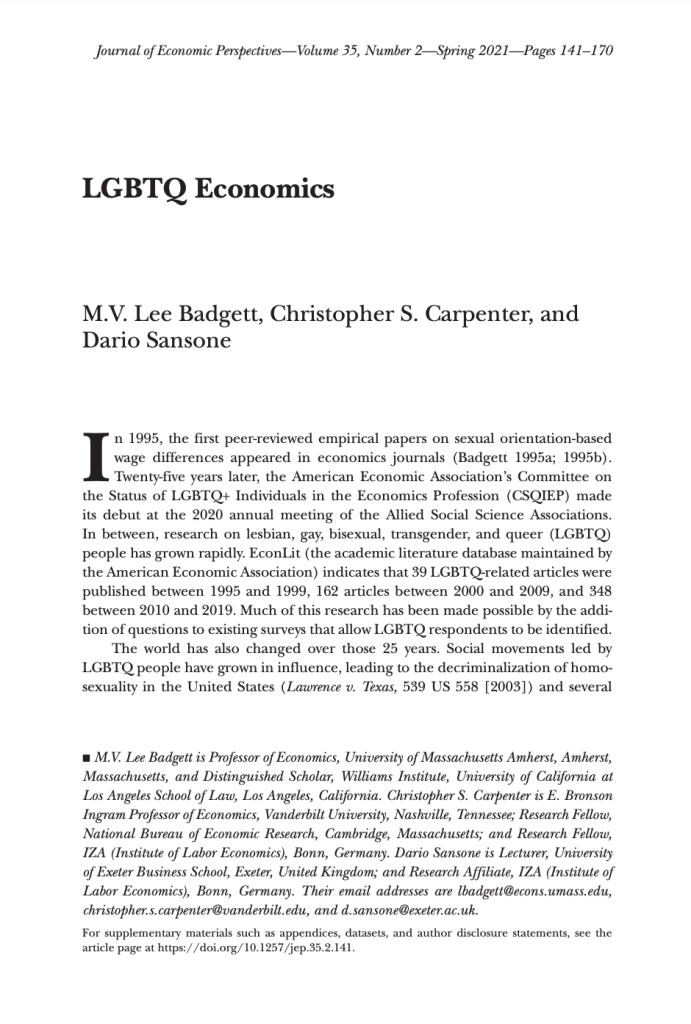Lots of scholarship has examined shifts in attitudes toward gender and sexual minority populations. I’ve written about this issue a bit (Diefendorf and Bridges 2020). And a good deal of that work has documented liberalizing trends in people’s attitudes. Much of my own work and collaborations on this topic has asked how these attitudinal shifts have translated into shifts in practice. We know less than we should, however, about whether and how shifts in attitudes here might have translated into material benefits for LGBTQ+ people. Recently, I invited the feminist economist MV Lee Badgett to come speak at UCSB. She came to give a talk about how to reach the public and affect change with social science research.
Side note: If you’re interested in connecting with the public, MV Lee Badgett’s The Public Professor: How to Use Your Research to Change the World (NYU Press, 2016) is about as good a place to start as I’ve found.
Dr. Badgett’s talk was amazing. She presented on work she’s been doing on LGBTQ+ demography in the U.S. A lot of her work focuses specially on labor market discrimination against the LGBTQ+ population in the U.S. This is the work of hers I have taught for many years and that I was familiar with when she came out to talk. She talked a great deal about how to communicate findings to the public about politically sensitive or volatile topics. And she used her own work as examples throughout. It was completely fascinating. Among the work she presented was a recently published article she coauthored with Christopher S. Carpenter and Dario Sansone published in the Journal of Economic Perspectives, “LGBTQ Economics.” I read the paper after listening to her talk because I didn’t recognize the citation in her talk. The paper summarizes an enormous body of economic in economics (and related fields) on gender and sexual inequality.
In her talk, she talked about some of her own work on LGBTQ wage discrimination and income inequality. I was familiar with the work documenting a negative wage gap for gay and bisexual men (compared with heterosexual men), but a positive wage gap for lesbian and bisexual women (compared with heterosexual women). And she discussed the ways economists and sociologists have attempted to document the ways that both discrimination as well as different family decisions (that are both shaped by and shaping gender inequality) for same-gender couples compared with heterosexual couples explain these outcomes.
But then she discussed a new finding I had not read about before. She discussed the fact that we know far less about whether attitudinal shifts in the U.S. toward LGBTQ folks have translated into shifts in their economic status over time. This I knew. I also knew about the work documenting gay/bi men’s wage gap and lesbian/bi women’s wage premiums as decreasing over time (e.g., Klawitter 2015). She explained how and why finding the data for this is challenging. Lots of work seeking to make generalizable attitudes has sample size issues or struggles because of the diverse ways sexualities are measured on representative surveys (for the uninitiated, how we ask about gender and sexualities is a seriously important issue and one about which we continue to need more research). Badgett and colleagues used data from the American Community Survey to attempt to address shifts in the economics outcomes of same-gender couples over time using U.S. data.
Spoiler: Badgett and colleagues discovered that the “wage gap” men in same-gender couples experience has persisted over time (Panel B below – the bottom figure); but the surprising finding was that the “wage premium” experienced by same-gender women appears to have declined precipitously since 2000 (Panel A below – the top figure). This shocked me and was not a discovery I was familiar with. (And if you’re into reading the notes, read footnote 17 on page 163 and you’ll note that they observed this trend in the raw wage gap data, including or excluding outliers, even when part-time workers were included, and more.)

I had so many questions after hearing her discuss the finding. One immediate question is whether this is a question of straight women’s gains or lesbians’/same-gender couple losses. I think that’s actually harder to answer than it might feel like it should be. It might also be true that those identifying as in same-gender couples on the ACS (even over this short period of time) have changed, partially accounting for growth in younger and more racially diverse people reporting being in same-gender couples in the most recent data here. We know that is true for questions about sexual identity; so it seems logical that it would also be true for reporting on being a part of a same-gender couple.
But… that doesn’t necessarily explain the gendered effect here–why did the wage premium evaporate for same-gender women couples, but the wage gap persist for same-gender men couples? Yet, it’s also true that same-gender men couples are being compared with the highest earners here (heterosexual, coupled men) while same-gender women are being compared with the lowest earners (heterosexual, coupled women). So, part of me feels that this might be more of a story of gains among heterosexual partnered women than losses for same-gender partnered women.
I’m completely intrigued and I hope someone writes their dissertation on the issue. It’s important. And, if nothing else, it made me realize that I read less work by economists than I should. But… to be fair, there are fewer economists like Dr. MV Lee Badgett than there should be. And I’ll be the first to read more research in economics as that shifts.


